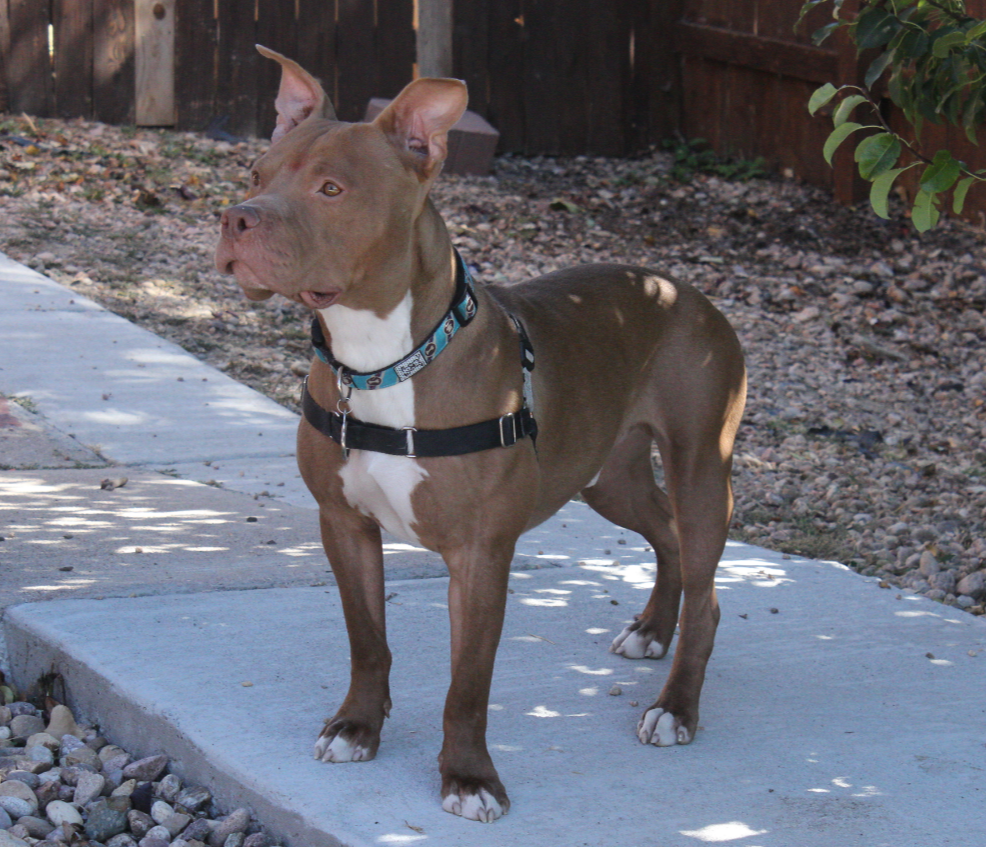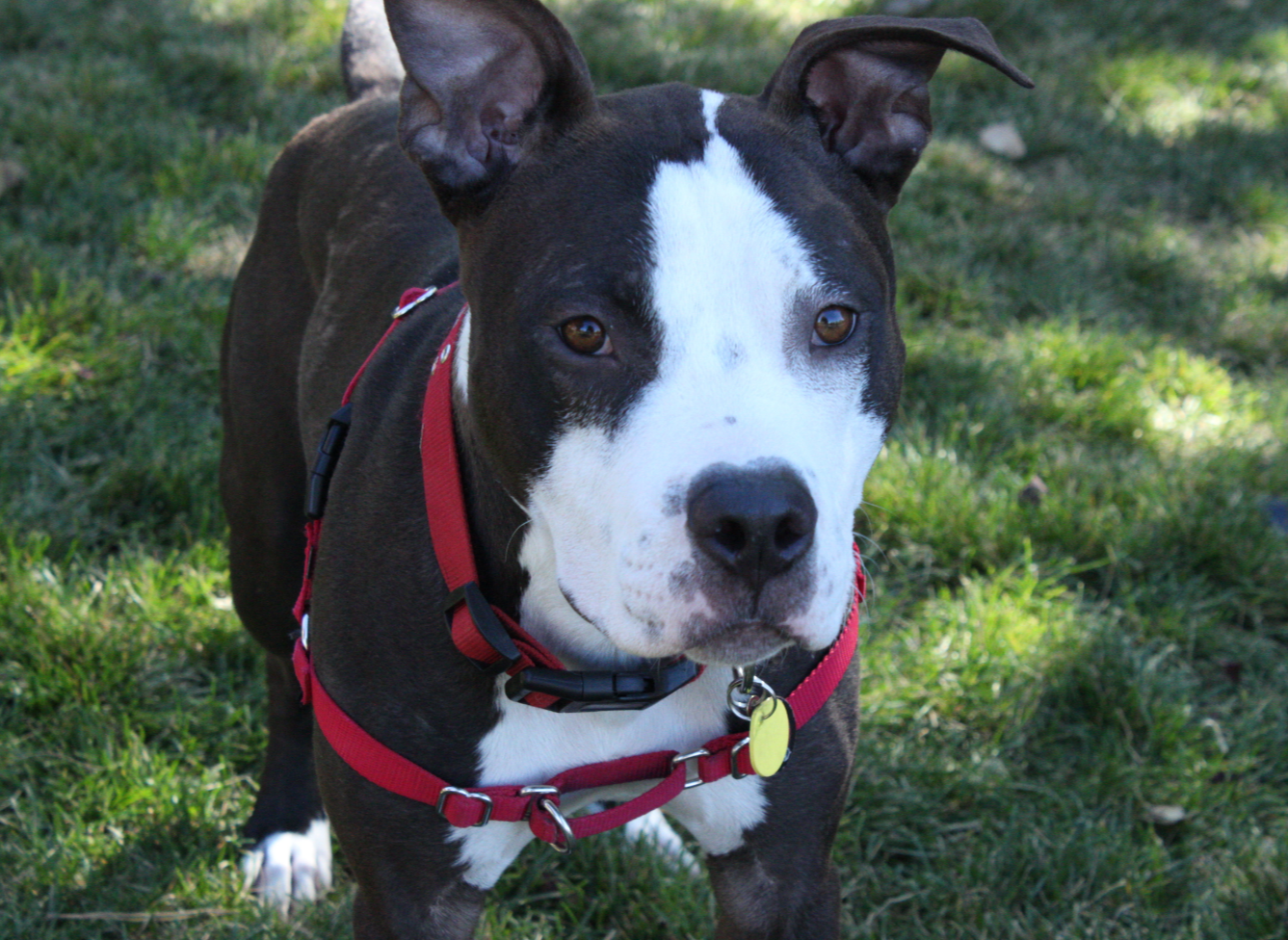Written by Charissa Beaubien KPA-CTP, CPDT-KA, SDT Head Trainer
Today I am going to talk about pit bull terriers. You’ve all likely seen many posts or articles on pit bulls, maybe even more so this month. October is Pit Bull Terrier Awareness Month and I want to do my part to bring more attention to the dogs that I work with every day.
I find it particularly interesting that many of my pit bull-owning clients often reach out with a tone of uncertainty when we first chat. They almost always ask me tentatively if I like the breed or if I have worked with them before. Even clients who have been sent to me from people who know that I enjoy the breed and have been told I won’t judge them for the dog that they have still approach with a level of hesitation.
I tell them that I have worked extensively in shelters and rescues and that usually comes with many encounters with pit bull or bully breed dogs. Some of my stories are wonderful, some sad, and others scary. But I have never blamed the breed I was working with, nor the species as a whole. Many dogs who would fail behavior evaluations or were returned due to behavioral issues had the unfortunate circumstance of living in a human world. Humans are the species that creates the “evil” that many see in bully breeds. In the past it has been German Shepherds, Rotweillers, Dobermans, and even the Chihuahua on the receiving end of this confusion, but much like today's bully breeds, these animals themselves are not to blame. Luckily for these dogs, this misunderstanding is not because all people are evil or cruel but are only misinformed. This misinformation is what I want to talk about this month.
Propaganda
I first want to highlight the role of propaganda in the matter. At least once a week I hear of a dog attack story - this is mostly due to the overwhelming flood of “dog stuff” I subscribe to on my social media. Many times these attacks involve and are inevitably blamed on a pit bull type dog. When photos are included in the news story, often times the dog pictured is not a Pit Bull Terrier but something with a similar body type or look thus labeled as such. It is hard for people to see past that big square head or firm body that so many breeds possess. Test yourself! Take your own “Pick the Pit” test here or here.
Additionally, the media coverage is one sided when it comes to covering dog attacks. A non-pit bull type dog would have to attack almost 5 people or kill a person to receive the coverage a pit bull attack receives. This leads people to have a very biased opinion of the breed as a whole, due to a psychological phenomenon called “Ingroup Cohesion” (check out NPR's “Is he Muslim" for another application of this). This phenomenon pulls people towards things that they know. For example, if you’ve grown up with a golden retriever who you felt an emotional bond with you’re more likely to be drawn to Goldens now. Likewise seeing words such as “aggressive pit bull attacks” leads people to think of their own mortality and thus the object of their fear then is labeled as evil. This feeling is then generalized to any story or interaction that takes place in the future. We then place pit bull terrier in their own group of humongous pack of bad creatures that all act and behave the same. This is simply a coping mechanism we do subconsciously but needs to be brought to the forefront.
When we look at any group of species we often see abnormal things within the group which lead us to form opinions of the group as a whole. This is why racism, sexism, ageism etc. continue to plague our nation. And why so many puppies and dogs are being labeled, blamed, killed, and ‘trained’ with archaic tools. It is not the breed as a whole that should suffer for the few instances of untrained, poorly socialized, or ill-mannered individuals. I want to remind you that these creatures cannot speak out, they cannot effectively communicate, or help themselves out of the human world that we’ve made them exist in. Because of this we need to look at the individual animal, their needs, and their history.
History
The history of American’s fear of canines started with the floppy eared Blood Hound. These dogs were seen as "blood thirsty" beasts that would maim on sight. But that is what they were used for - blood hounds tracked and brought down slaves that had escaped. Is that the dog to blame or the person who trained it?
The blood hound is only the first example in this sad saga however - many breeds throughout the years have been labeled in many ways. Ask anyone their opinion on dogs and they’ll have a story to tell. Maybe it’s as harmless as the shaking Chihuahua they owned or the drooling St. Bernard. Or maybe it's a more serious story about the breed of dog that bit them as a child. Either way, these are opinions of one person in a sea of many.
More recently in our history President Obama stated in 2013, “[W]e don’t support breed-specific legislation (BSL)– research shows that bans on certain types of dogs are largely ineffective and often a waste of public resource. And the simple fact is that dogs of any breed can become dangerous when they’re intentionally or unintentionally raised to be aggressive.” This statement has been proven to be true time and again in any country or city with BSL laws. The biggest example is Denver, Colorado which has one of the toughest bans in America and yet ranks highest in the nation in dog bites. (Additionally, according to the Denver Animal Shelter three unknown “professionals” decide if your dog is a pit bull or not. What is a professional and what are they a professional in, is not outlined.)
Professionals
This brings me to the many “professionals” who claim to be dog trainers but who are aiding to the downfall of the pit bull terrier. In 2017, animal trainers are still not regulated by any leading authority, that means that anyone can call themselves a dog trainer. While I have worked with many competent dog trainers who don’t have any titles or certifications, I have also worked with many people who do not understand the behavioral sciences. This is dangerous because one mistake can lead us down a slippery slope that can cause severe setbacks to the entire industry. It is well documented in scientific research that the use of outdated tools (electric collars, prong or choke collars, and spray bottles) often lead to heightened aggression in dogs and people. Check out these and many other studies on the subject: “If You're Aggressive, Your Dog Will Be Too”, "How the Alpha Roll Can Turn Your Puppy into an Aggressive Dog".
The “professionals” who are often seen working with pit bull terriers and other bully breeds often subscribe to outdated tools such as these, due to the ‘look’ that they give the dog. That then leads to outdated teachings such as dominance theory, alpha pack theories, and needing to have "a strong hand with a strong dog". This is simply untrue. One of my new favorite quotes is “If it works only for one species it isn’t learning” – FDSA Podcast. If I can train a tiger, lion, and bear I can train a strong breed and all of the above can be naked (no aversive training tools necessary).
Train the Dog, Not the Breed
So how do you create a happy well-adjusted dog of any breed? Start young! Check out Laura VanArendonk Baugh’s new book Social, Civil, and Savvy for a great puppy raising read! Create early positive experiences in short doses daily and get support from a great dog trainer who is recognized in the industry for using scientific-based training methods. This is true for your older dog as well - working your dog’s brain and brawn is important for all breeds at all ages! I would also encourage everyone to ensure your dog is getting good (mental and physical) exercise outside of the confines of the back yard, a good biologically sound diet, mental stimulation, and FUN things daily.
Additionally, when it comes to those around you who may already have a breed bias, remember that they are just misinformed and that we cannot change their mind with more unkindness towards them or our dogs. Check out “Flip the Script” for more on how to approach people kindly who disagree with you. In this case we can also use systemic desensitization through exposing people in low (but positive) doses to good, healthy bully breed dogs as they are comfortable. But above all, be kind to their fears of dogs and breeds, and show them how smart your dog is!
For more on pit bull terriers and how to help your community check out Best Friends and research more on pit bulls and BSL in your area.
Photos courtesy of Jordan Flagg


